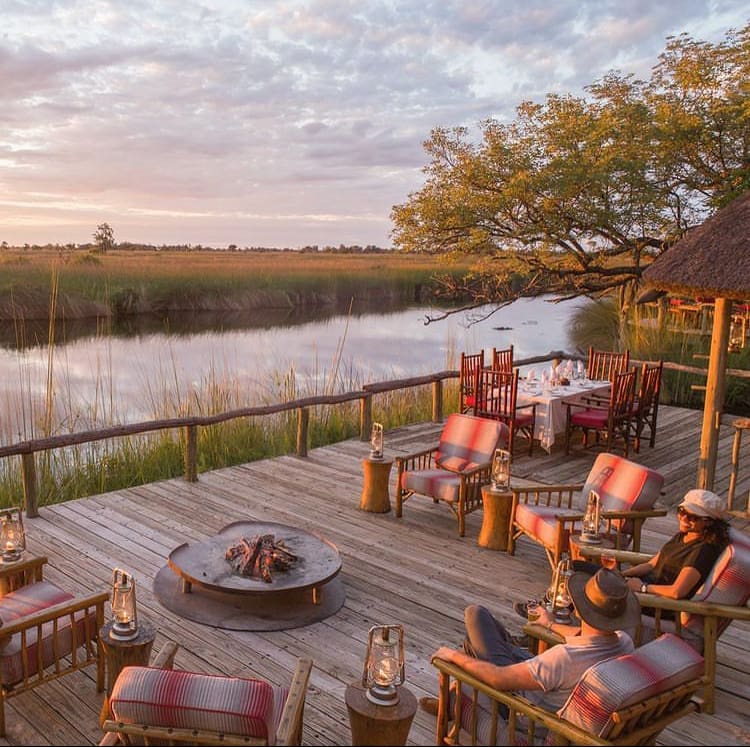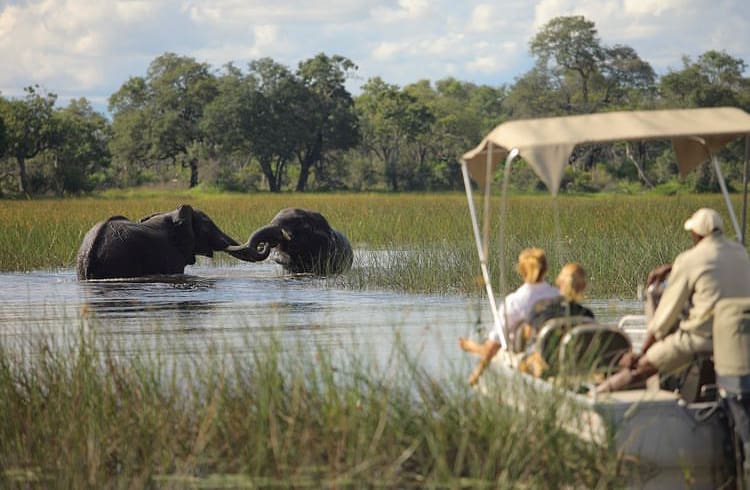Botswana is a landlocked country located in Southern Africa. The country covers an area of 581,730 square kilometers (224,607 sq mi) and over 2.3 million people. Botswana borders South Africa to the south and southeast, Namibia to the west and north, and Zimbabwe to the northeast. Its border with Zambia to the north near Kazungula is poorly defined but is, at most, a few hundred meters long. The landscape of Botswana is mainly made up of desert plains. Botswana has some grassland and savanna areas and is primarily found in the north and northeast of the country.
The climate in Botswana is semi-arid. The country experiences two main seasons: a wet season from October to April and a dry season from May to September. The average rainfall in Botswana is around 500 millimeters per year.
However, the amount of rainfall can vary significantly from year to year. The country typically receives most of its rain during the wet season. The average temperature in Botswana is around 20 degrees Celsius. However, the country can experience extreme temperatures, with highs of over 40 degrees Celsius and lows of below freezing. Botswana is also susceptible to droughts.
Here’s a monthly breakdown of Botswana’s weather and climate:
January-March
January-March is the hottest month in Botswana, with temperatures reaching 40 degrees Celsius (104 degrees Fahrenheit). Daytime temperatures average in the low to mid-20s Celsius (low to mid-70s Fahrenheit), while night-time temperatures can dip down into the single digits Celsius (upper 30s Fahrenheit). Very little rainfall during this time of year, so the country is generally quite dry. However, Botswana does experience some windy conditions during these months, so it is essential to be prepared for gusts of wind when traveling.
Things you can do in Botswana from January- March:
- Visit the Chobe National Park
The Chobe National Park is Botswana’s first national park and one of the largest in the country. The park covers an area of 10,566 square kilometers (4,068 sq mi) and is home to various wildlife, including lions, elephants, Zebras, and Giraffes. The park has a variety of landscapes, from forests in the north to the open plains in the south. The Chobe National Park is famous for its large population of African elephants. It is estimated that there are over 120,000 elephants in the park. The park is also home to the world’s largest concentration of Cape buffalo.

You can do various activities in the Chobe National Park, including game drives, boat safaris, and walking safaris. You can also visit the park’s many lodges and campsites.
- Take a safari in the Moremi Game Reserve. Moremi Game Reserve is a protected area in the Okavango Delta. It covers an area of 5,850 square kilometers (2,260 sq mi)and is home to various wildlife, including lions, leopards, elephants, and buffalo. There are also a wide variety of bird species in reserve. Several lodges, campsites in the Moremi Game Reserve, and various safari companies offer game drives and walking safaris.
- See the Makgadikgadi Pans.

The Makgadikgadi Pans are a group of salt pans in the Kalahari Desert. The pans cover an area of 3,900 square kilometers (1,500 sq mi) and are some of the largest in the world. Tourists are attracted to the Makgadikgadi Pans for their unique landscape and wildlife, including flamingos, pelicans, and ostriches. Safari companies offer game drives, walking safaris, and quad biking safaris. You can also stay in one of the many lodges and campsites located in the park.
April-June
The weather in Botswana from April-June is cooler and dryer than in the previous months. Temperatures range from 20 to 30 degrees Celsius (68 to 86 degrees Fahrenheit). The average daytime temperature during this period is about 30 degrees Celsius (86 degrees Fahrenheit), while the average nighttime temperature is around 15 degrees Celsius (59 degrees Fahrenheit).
There is little rainfall during this time of year, although thunderstorms can occur. This is the ideal time to visit Botswana for those who want to avoid the heat and the crowds. The dry conditions also make for good game viewing, as the animals congregate around water sources. Some tourists may find the cooler temperatures too chilly, so be sure to pack some warm clothes if you plan to visit during this time.

Things you can do in Botswana during April-June
- Visit the Tsodilo Hills. The Tsodilo Hills are a group of hills in the Kalahari Desert. The hills cover an area of 1,100 square kilometers (430 sq mi) and are home to various rock art. It is the largest concentration of rock art in the world. This UNESCO World Heritage Site is also home to different animals, including lions, leopards, and elephants. It is located in the northwestern part of Botswana, near the border with Namibia. The Tsodilo Hills are only accessible by four-wheel drive vehicles.
- See the San Bushmen. The San Bushmen are the original inhabitants of the Kalahari Desert. They are nomadic people who live off the land. They are found in the northwestern part of Botswana, near the border with Namibia. The San Bushmen are known for their unique culture and way of life. They are also known for their traditional hunting skills. You can visit a San village to learn more about their culture and way of life.
- Visit the Nxai Pan National Park. The Nxai Pan National Park is a national park in Botswana. The park covers an area of 2,360 square kilometers (910 sq mi). Located in the Kalahari Desert, the park is home to various animals, including lions, leopards, and elephants. There are also a wide variety of bird species in the park. Here you can also see the Baines’ Baobabs, a group of baobab trees featured in National Geographic magazine. The Nxai Pan National Park is accessible by four-wheel drive vehicles only.
- Explore the Kgalagadi Transfrontier Park. The Kgalagadi Transfrontier Park is a national park in Botswana which covers an area of 3,900 square kilometers (1,500 sq mi). It is famous for its red dunes, some of the world’s highest. The park is also home to various animals, including lions, leopards, and elephants.

July-September
July-September is Botswana’s coldest time of year, with temperatures averaging 10 to 15 degrees Celsius (50 to 59 degrees Fahrenheit). This is also the country’s dry season, so visitors can expect to see little rainfall. The dry conditions make for good game viewing as the animals congregate around water sources. Some tourists may find the cooler temperatures too chilly, so be sure to pack some warm clothes if you plan to visit during this time.
The coldest month in Botswana is July, when temperatures can drop to as low as 5 degrees Celsius (41 degrees Fahrenheit). However, the country generally has a warm climate all year round. Activities such as game drives and safaris are available all year round.

Things to do in Botswana during July- September
- Take a boat cruise on the Chobe River. The Chobe River is a river in Botswana. The river flows through the Chobe National Park and is home to various wildlife, including hippos, crocodiles, and birds. A boat cruise is the best way to see nature. You can also go on a game drive in the national park.
- Visit the Okavango Delta. The Okavango Delta is a wetland in Botswana. The delta covers an area of 15,000 square kilometers (5,800 sq mi) and is one of the largest inland deltas in the world. You can explore the delta by boat or on foot. What makes it famous is the Okavango River, which flows into the delta and then disappears into the sand. Here you can see various animals, including lions, leopards, and elephants.
- Explore the Kalahari Desert. The Kalahari Desert is a desert in Botswana. The desert covers an area of 2,500 square kilometers (970 sq mi). It is located in the north-central part of the country. As its name implies, the Kalahari Desert is an arid place. However, it is home to various animals, including lions, leopards, and elephants. It is also home to the San Bushmen, a nomadic people who live off the land. You can visit a San village to learn more about their culture and way of life.
- Visit the capital city of Gaborone. There are several things to do in Gaborone, including exploring the city’s museums and monuments, enjoying the nightlife, and shopping for souvenirs. It is also recommended to try some local cuisines in Gaborone, such as Botswana beef stew or seswaa (a type of meat dish).

October-December
October-December is the cooler month in Botswana, with temperatures dropping to around 20 degrees Celsius (68 degrees Fahrenheit). This is also the country’s green season when rainfall is more common. However, rain is still relatively light compared to other parts of Africa. The green season is an excellent time to see Botswana’s landscapes at their best, as the vegetation is lush and green.
December is the busiest month for tourism in Botswana, so visitors can expect higher prices and more crowded conditions. This is also the country’s hot season, with temperatures averaging 30 degrees Celsius (86 degrees Fahrenheit). The hot weather can be unbearable for some, so pack plenty of sunscreen and water. December is also the start of the wet season, so visitors should be aware that rains are possible. Roads may become impassable, so it is important to check conditions before traveling.

Things to do in Botswana during October-December
- Take a hot air balloon ride over the Okavango Delta. The Okavango Delta is a wetland in Botswana. A hot air balloon ride is the best way to see the delta. You can also go on a game drive in the national park.
- Go bird watching. With over 550 different species of birds, Botswana is a paradise for bird enthusiasts. The Okavango Delta, Chobe National Park, and Moremi Game Reserve are some of the best places to watch bird watching. This is best done during the dry season when the water levels are lower, and the animals are concentrated around the remaining water sources.
- Go on a Safari. The best time to see wildlife is from October to December when the animals are active and the weather is good. Botswana has plenty of options for safaris, from budget-friendly to luxurious. Choose the safari right for you and get ready to spot some of Africa’s most iconic animals, including lions, elephants, and giraffes.

Conclusion
Botswana is a beautiful country with much to offer tourists. The best time to visit is during the dry season, from October to December. This is when temperatures are more relaxed, and the landscape is at its most lush and green. Botswana has many things to do, including taking a hot air balloon ride over the Okavango Delta, witnessing the zebra migration, and bird watching. So pack your bags and head to Botswana for an unforgettable vacation.
